 translate to:
translate to:
 translate to:
translate to:
|
|
Translated by Dmitriy Sharov
We have walked down that part of the Viertotie, which used to be the center for trading and business life of Terijoki. At the "Washer", the street turns right again and runs further by the beach. In between the gulf beach and the Viertotie there is the Terijoki recreation area.
Across the street from the "washer" -there is a small park with a sculpture of Lenin: the right hand is traditionally frostrated in the pointing jesture, the traditional hat is grabbed by the left.
Some time ago there were several trading shops in place of the small park, the Korhonen old drugstore used to be the most famous, the newer drugstore was located by the railway bridge next to the houses of Axel Toivola. Among the others, there also were Hänninen curtain workshop, meat store of Poshekhonov and other relatively small facilities.
None of those managed to survive by our days, but on top of the hill above the park, there is a glorious, building of the 445th school, constructed in the so-called Stalin manner. A wide stone stairway leads to the front door. The stairway ends with a view spot, from where you can enjoy the view of the park and the Gulf of Finland. All this ansamble - the park, monument and school definitely represents an architecture dominant of the former Soviet Zelenogorsk. By the way, there was a Finnish school somewhere around this spot in the past, it used to be the oldest school in Terijoki, founded as early as in 1882.
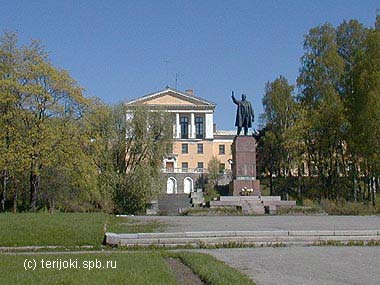 |
 |
| The view of the 445th school and monument to Lenin. | The view of the park and Gulf from around the school. |
Having crossed the Viertotie from the park in front of the school to the South (presently known as the Primorskoye Shosse, we will find ourselves at the entrance of the former Firefighter"s park or the Public Park, known these days as the Zelenogorsk park for recreation and culture. In the so-called Russian Dacha period, the park was known as the center of any kinds of social life of the St. Petersburg dacha public. The Park touches the very seashore, where you can get walking down a straight and wide path. The seashore was occupied by the Kurghaus (casino), water medical facility, concert hall and a restaurant with a hall, which was many dozens meters long. All these wooden summer buildings were disassembled and totally sold out immediately after the Civil War.
On the very beach sand, there used to be the yacht club, founded in 1910, by the inspiration of admiral Skrydlov. The yacht club had its own harbor, which was used as a shelter from storms. Finlanders have the version that in the matter of fact, the Russian military had plans on using this facility for their own sinister purposes.
In the tricky post-revolution years the harbor wavecutter was being used as a port for military ships of the intervents (click here for details). Not too long ago this harbor was also occupied by walkabout scooters, linking Zelenogorsk with Leningrad, Kronshtadt and Petrodvorets. Today it is being lost and empty and can only be used by amateur windsurfers.
 |
 |
| The former yacht-club harbor. It is well seen, that now the wavecutter is covered with piles of sand from the West side. | |
 |
 |
| The wavecutter view towards the seashore. This side used to be occupied by the Kurghaus (casino), restaurant and things like that. | |
The park used to have playgrounds for lawn-tennis and a stadium. For the sake of various public celebrations, the stadium used to be equipped with a stage.
The Public Park was used for celebrations not only by Russian dacha people, but also by the local Finlanders. For instance, in 1910, it accommodated the grandious patriotic song festival. This celebration, organized by the local nobility, "Young Finlanders", lead by Mikko Uotinen, has pushed the national orientation of the local population. The local choir amateurs, choirs of estonians and ingermanlanders, presentations of the most known finnish poets and arts people, and in the end of all - the patriotic choral "God, bless the people of Finland". The hearts of thousands of participants, guests and spectators were unified in a single patriotic feeling. In the restaurant, mentioned before, there was a final banquet of the celebration for the guests and administration. People were taking not taking home before 6 am in the morning. The celebration has frightened the Russian administration. When the fact was clear, that it was going to attract thosands of civilians, the military forces of the nearest fort Ino, was brought into the nunmber 1 readiness; the St. Petersburg administration was standing by for the mass rebelion. There were speculations, that the Finlanders were singing and hiding their weapons at the same time. Of cource, no rebellion happened then. Finlanders, in accordance with their mentality, preferred all the legal ways of resistance.
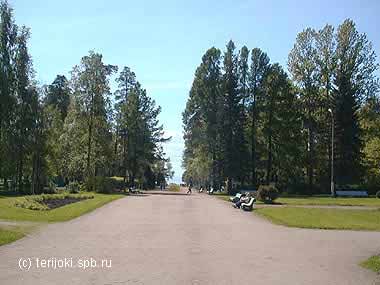 |
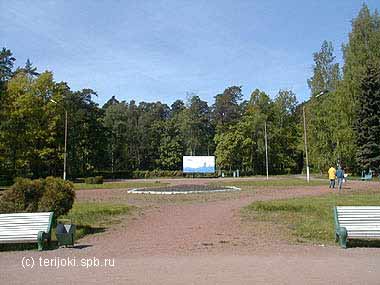 |
| The central alley of the park | The former stadium - concert ground with a stage. |
In 1922 on the Viertotie, right at the park gates, to the left of the entrance, there was the Terijoki Club, or the communal house - the Seurahuone. For this purpose, an old dacha building was moved from Kellomäki, the architect Uotila had remodelled the building. The building had a big public hall, restaurant, and a hall for the communal administration. At the same time, the Firefighters park (Palokunnan Puisto), was renamed into the Club park - Seurahuoneen puisto. This glorious building does not exist nowadays, and nothing reminds about where it was and what the building looked like.
However, we are now leaving the park on the Viertotie and moving further to the West.
In the beginning of the 20th, when peaceful life stabilized after all the sinister things, the local administration decided restart the pacified beach life on the shore. For this purpose they organised the Terijoki sea resort (Terijoen Merikylpylä - literally the Terijoki sea bathing place). They chose a territory to the west from the Club Park, between the streets of Seurahuoneenkatu and Mikonkatu (currently Mallinnaya and Theatralnaya). There were several dachas on this territory, almost all of them became hostless after the revolution. Only one of them - Dr. Zimmermann´s dacha has kept its owner. Doctor Zimmermann used to be the director of the sanatorium Pitkejärvi, near Jälkala (where George V. Plekhanov died in May, 1918). Zimmermann has also been one of the owners of the new sea resort. In one of the dachas, known as the Leponi bungalo, they opened the sea resort casino. By the way, this dacha was also known by the fact that Vsevolod E. Meyerhold used to live and work there in the summer of 1912. The building itself did not survive. Today, the territory of the former sea resort is totally covered by pine forest.
Opposite the former sea resort, on the other side of the Viertotie, there is a restaurant called "Olen" ("Deer"). It used to be one of the town´s landmarks of the soviet period Zelenogorsk and the place of pilgrimage for Finnish tourists, but for the last 10 or 12 years it is in emptyness and oblivion. Nevertheless, they say that the former Soviet leader Leonid Brezhnev had a reception there for the former president of Finland Kekkonen, who is also dead already. Several years ago, they started some slow going works, but the enthusiasm of the new owners has apparently faded pretty soon.
 |
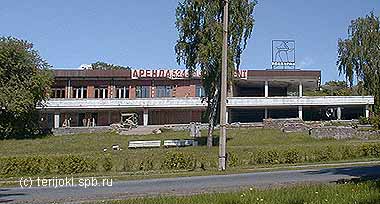 |
| Restaurant "Olen" in the 80ties and today. | |
The Terijoki recreation area doesn´t finish right at the border of the Sea Resort. The territory of the hotel "Belle Vue" is located on the corner of the Viertotie and Mikonkatu. It used to be the oldest hotel in Terijoki, founded as early as in 1874. After the revolution, the ownership has been changed and the hotel has got to be known under the name of Puistola (Park Hotel). The hotel building is still there today. This is a big building in the Terijoki standards, two-storey, of an original architecture style. It is on the corner of the Viertotie and Mikonkatu. The walls are made out of logs and brushed outside, what is not common for this area at all.
 |
 |
| The corner of the Mikonkatu (presently Theatralnaya Street) On this old photo on the left - are the gates of the Sea Resort (Merikylpylä), then further - the gates of the hotel Puistola. On the new photo - is the same place, but right now all of them are missing. | |
Today this building looks slightly forgotten, but it is not empty. Right now it is owned by one of the local culture centers - the workshop of Zelenogorsk painters and an art school for children.
 |
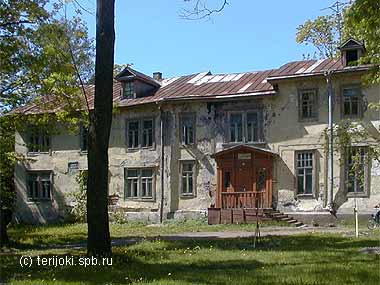 |
| Belle -Vue/Puistola then and now. The front entrance looks simplier today, but the configuration of the windows is still recognisable. There is a green lawn in front of the front entrance today, but there used to be a taxi parking back in the 30ties. | |
Having walked down the Mikonkatu further to the gulf, we will spot a large wooden building on the right. It apparently used to look more festive in the past, right now it is worn and keeps traces of fire on the facade. This is another Terijoki landmark, the Müser"s dacha, or recreational facility. Back at the times of the Soviet room, this building was hosted by the city administration. This building has been empty for the resent years, even though it is guarded by the militia.
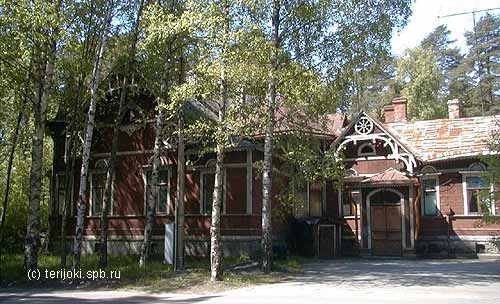 |
| The Müser"s dacha. (Müserin huvilla). View from the Mikonkatu. |
The interior of the city administration building used to be decorated by fancy ovens and fireplaces, which were also part of the local lifestyle. Their present condition is unknown to the author. The locals claim this particular building to be the real former "Belle-Vue/Puistola". However, this point of view can be easily rejected by investigating old Finnish photographs and maps.
 |
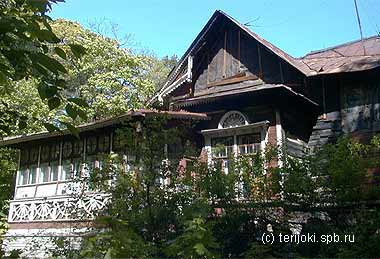 |
| The Müser´s dacha. View from the left, the terrace side. The curved front side is destroyed by the fire. | |
Right opposite the Myser"s dacha, on the left side of the Mikonkatu, there is the house of doctor Zimmermann.
 |
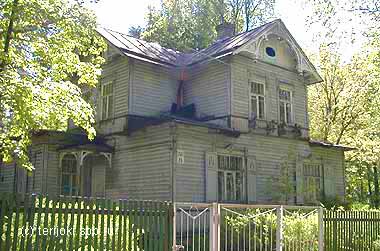 |
| Dr. Zimmerman"s house on the Mikonkatu. The left photo is from the Finnish photoalbum, apparently, taken after the war. | |
Having walked further towards the gulf, we will see a small green house on the left side of the street. On a Finnish map dated back to the 30-ies, this place was occupied by the house of the lensman´s assistant, Mikko Porvali (lensman is something like the head of local administration in Finland).
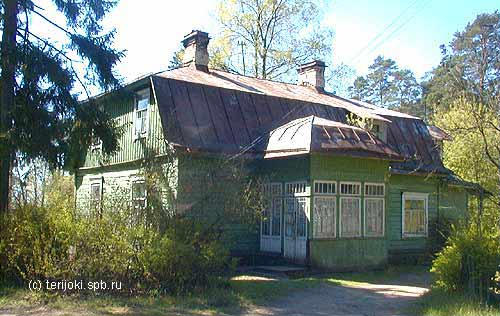 |
| Mikko Porvali´s house on the Mikkonkatu. |
The street of Mikkonkatu ends here and transforms into the beach. Back in the 20-ies and 30-ies, at the time, when the Sea resort was functioning actively, there was a long line of blue-white dressing rooms along the beach line, which were looking like a cluster of hives or bird houses, and there were as many people, as in Sochi in the summer.
As walk to the right a little down the beach, and passing the rescue station, we are about to see the place, where the Terijoki brook ends up it´s way towards the gulf. Gradually beating through the beach sand, brownish peat waters are flowing into the waters of the gulf.
 |
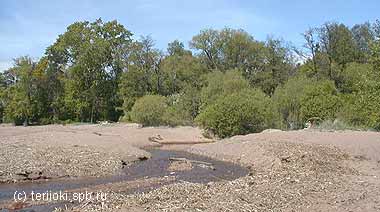 |
| The mouth of the Terijoki river. View from the Eastern (left) bank. | |
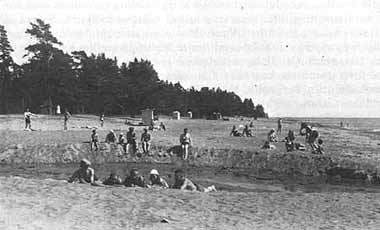 |
 |
| The mouth of the Terijoki river. View from the western (right) bank. The photograph on the left was taken in the beginning of the 20-ies, when the Sea resort was not yet working, and there was no pilgrimage of tourists. | |
However, we have to get back to the Viertotie. On the other side of the street, right opposite the former territory of "Belle-Vue", there is a two stored wooden building with beaten up windows. This is the former Russian people´s school. (The so-called venäläinen kansakoulu). The school was founded in the very beginning of the 20th century for children of the dacha people, who used to live here all round the year, and also for trades, and other settlers. Some of the local Finns were also bringing their children here to make them get more fluency in the Russian language. The school was open until 1939. Until recently, this building used to belong to the sports society, called "Dynamo". These days the building is empty and obviously doomed.
 |
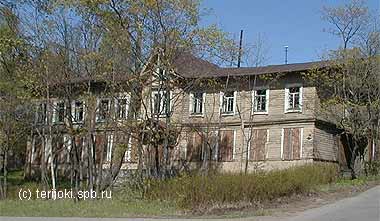 |
| The former Russian school. The left photo is from a Finnish photoalbum, after the war. | |
Passed the Russian school, we are walking over the bridge above the Terijoki brook, (if we can call it a bridge, it is more like a pipe), and on the right side of the street we see a two store stone building of a yellowish color. This is the former Poshekhonov´s store (still a foodstore these days). Up to 1939, the Poshekhonov family was pretty famous and respected in this area. One of them is burried on the Terijoki military cemetary (next to the Lutheran church), among the 75 soldiers, who were killed in 1939-1944 in the fight for the independence of Finland.
 |
| The Poshekhonov´s store. |
Immediately behind the Poshekhonov´s store, to the right from the Viertotie there is the street, we are walking down now. Today it is the Krasnykh Komandirov Street (Street of the Red Army Commanders), but it used to be called Antinkatu. It runs back to the Viertotie right at the railway bridge. This is an entirely different district, judging from the style of architecture. It used to be full houses of the Terijoki settlers (landlords, traders, clerks), and a limited number of dachas. No trading facilities around. This was a quiet street, running between gardens full of fruit trees, maples, limes and oaks, saying nothing about the blooming flowers. Dahlias were flaming bright, surrounded by marigold and Indian cress.
The Tirijoki brook is flowing on the right, behind the houses, between the Antinkatu and Viertotie. At the middle part of the Antinkatu, the brook is surrounded by distant slopes of various steepness, and there are no houses on these sides of the brook. In this area, the brook forms a wide, long valley, covered by all kinds of green wilderness. This quiet and "wild" spot in the middle of the settlement, represented a sharp contrast, compared to the noisy and crowded Viertotie, the boot rattle of marching solders of the 1st Chasseur battallion on the Antinkatu, or clusters of people on the beach of the Sea Resort. Back in the Finnish, and even Soviet times, the valley of Antinkatu, used to be a joyful playground for local kids.
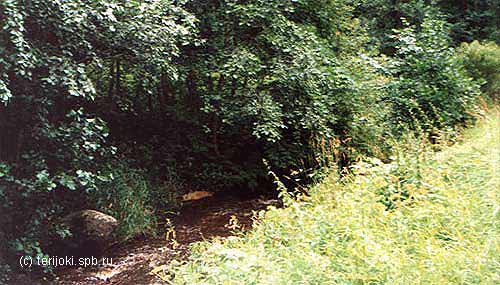 |
| The valley of Antinkatu today. |
The old housing is mostly replaced by modern dachas and cottages, but several houses built before the war still remain in place.
 |
 |
| The houses of Terijoki settlers on the Antinkatu. | |
 |
| A dacha on the Antinkatu. |
The street gradually runs uphill. As we pass about 2/3 of its length, we can now see the building Zelenogorsk city hospital. At first sighte - it is relatively modern, but in fact it´s part of the Finnish heritage, the sanitary facility of the 1st Chasseur battallion. The building was constructed back in 1938, and represents an example of "constructivism" in the architecture, along with the co-op store, mentioned earlier. In the Soviet times, two other wings were added to the building.
 |
 |
| The sanitary facility of the 1st Chasseur battallion | the Zelenogorsk city hopital |
The 1st Chasseur battallion (1 Jääkäripataljoona), used to be one of the first subdivisions of the Finnish army, formed immediately after getting independence. Initially, it was located in Kellomäki in the empty dachas, and it used to be known as the 1st Scooter battallion (1 Polkypyöräpataljoona). By 1924, there were barracks built in Terijoki. Those were Russian barracks, brought here from the fort of Ino, and the batallion was transferred onto the new place of location, and then renamed into the 1st Chasseur battallion.
Back in the 20ies and 30ies, the 1st Chasseur battalion used to be an important factor in the economic and culture life of the settlement. By the number of 1500 people, this formation could actually be considered regiment. When St. Petersburg dacha people disappeared, it became the biggest consumer of the local dairy products. Officers and unter-officers, by their wages, were supporting the tax flows into the community account. The batallion orchestra was an integral attribute of all local celebrations. The battallion sport teams (along with the teams of frontier guard and shootscor), were taking active part in the local sportlife. An example of the army and people being unified.
The barrack territories were located to the right of the Antinkatu, between the streets of Mielikinkatu and Otsolankatu (nowadays Lubimaya and Krasnykh Kursantov streets). There also was a large parade ground here, but now there is a birch grove. The barracks were located over the perimeter, the only thing that is left out - are foundations, all covered by bush. Somewhere around here, on the Antinkatu and surrounding streets, there used to be the residence of the batallion commander, dormitories for officers and the club of unter-officers. The Officer"s club was a bit more distant, in the former Novikov´s residence. We should also mention the fact, that subcolonel Strömberg (Siilasvuo) used to be one of the batallion commanders, who later became a famous general and hero of the war. After the World War Two, he conducted the Middle East peace talks.
After the barrack territory, the Antinkatu crosses the Terijoki brook and runs into the Viertotie. By turning left and passing by the Shahov´s house, we can get to the railway bridge and further to the train station.
The excursion is over.
Последние комментарии: